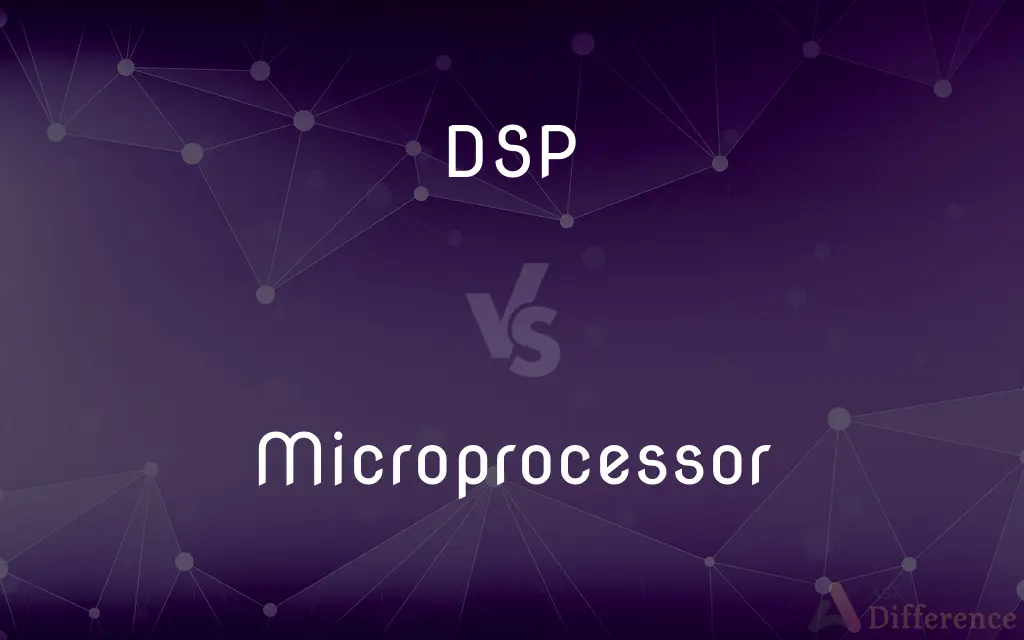DSP vs. Microprocessor — What's the Difference?
By Tayyaba Rehman & Fiza Rafique — Published on February 3, 2024
DSP (Digital Signal Processor) specializes in processing signals efficiently, often in real-time, whereas a microprocessor is a general-purpose processing unit for a wide range of computing tasks.

Difference Between DSP and Microprocessor
Table of Contents
ADVERTISEMENT
Key Differences
A DSP is designed specifically for high-speed numeric processing of digital signals such as audio, video, or sensor data, excelling in tasks that involve filtering, analyzing, or transforming these signals. On the other hand, a microprocessor serves as the central processing unit of a computer or device, executing a broad range of instructions for various applications, not limited to signal processing.
The architecture of a DSP is optimized for data-intensive, repetitive, and concurrent operations common in signal processing, often featuring specialized instruction sets, parallel processing abilities, and dedicated hardware for specific calculations. Microprocessors, while versatile, are designed for a wide range of tasks and may not have the same level of optimization for signal processing, prioritizing flexibility and general computational capabilities.
DSPs are predominantly used in devices where signal processing is crucial, such as in telecommunications, audio and video processing, radar and sonar, and medical imaging systems. Microprocessors, due to their general-purpose nature, are found in a vast array of devices, from computers and smartphones to home appliances and automotive systems, handling everything from basic operations to complex computational tasks.
In tasks involving digital signal processing, DSPs usually offer better performance, energy efficiency, and speed, as they are tailored for such operations. Microprocessors, while not as specialized, offer broad computing capabilities and are more adaptable to a variety of tasks, including but not limited to, signal processing.
Developing applications for DSPs often requires a deep understanding of the specific hardware and its capabilities, as well as proficiency in specialized programming techniques and tools. In contrast, microprocessors are supported by a vast ecosystem of development tools, programming languages, and resources, making them more accessible for a wide range of developers and applications.
ADVERTISEMENT
Comparison Chart
Primary Function
Specialized in digital signal processing
General-purpose computing
Architecture
Optimized for numeric calculations, parallel processing
Designed for a wide range of computational tasks
Typical Use Cases
Audio, video processing, telecommunications, medical imaging
Computers, smartphones, appliances, automotive systems
Efficiency
Highly efficient in signal processing tasks
General efficiency across a variety of tasks
Development Environment
Requires knowledge of specific hardware and signal processing
Broad range of development tools and programming languages
Compare with Definitions
DSP
Designed to perform multiple operations simultaneously.
The DSP's parallel processing capabilities make it ideal for radar signal processing.
Microprocessor
Designed to perform a wide range of computing tasks.
The microprocessor in the smartphone runs everything from apps to communication protocols.
DSP
Tailored for specific applications like audio and video processing.
The smartphone's DSP efficiently manages its audio processing tasks.
Microprocessor
Executes a broad set of instructions for software operations.
The microprocessor processes millions of instructions per second to run the operating system.
DSP
Capable of processing data in real time with minimal delay.
The medical imaging system relies on the DSP for real-time image analysis.
Microprocessor
The primary computing unit of a computer, executing instructions from software.
The microprocessor is the brain of the computer, handling all its operations.
DSP
A processor specialized in the manipulation and transformation of digital signals.
The DSP in the audio system ensures crystal clear sound.
Microprocessor
Fundamental component in digital devices for processing data.
Every modern electronic device has a microprocessor at its core for data processing.
DSP
Optimized for high-speed numeric operations on data streams.
The DSP handles complex calculations for real-time video encoding.
Microprocessor
Adaptable to various types of devices and applications.
The microprocessor is versatile enough to power both washing machines and space probes.
Microprocessor
An integrated circuit that contains a major processing unit of a computer on a single microchip, such as the central processor or the graphics processor.
Microprocessor
(computer hardware) the entire CPU of a computer on a single integrated circuit (chip).
Microprocessor
Integrated circuit semiconductor chip that performs the bulk of the processing and controls the parts of a system;
A microprocessor functions as the central processing unit of a microcomputer
A disk drive contains a microprocessor to handle the internal functions of the drive
Common Curiosities
Can a microprocessor perform signal processing tasks like a DSP?
A microprocessor can perform signal processing tasks but typically less efficiently than a DSP.
Can a microprocessor and a DSP be found in the same device?
Yes, many devices contain both a microprocessor for general computing and a DSP for specialized signal processing tasks.
What primarily distinguishes a DSP from a microprocessor?
A DSP is specialized for efficient digital signal processing, while a microprocessor is a general-purpose computing unit.
What makes DSPs efficient in handling signals?
DSPs are efficient in handling signals due to their architecture, which is optimized for high-speed numeric operations and parallel processing.
Are DSPs used in everyday consumer electronics?
Yes, DSPs are commonly used in consumer electronics, particularly in devices requiring audio, video, or communication processing.
How do the instruction sets of DSPs and microprocessors differ?
DSPs have instruction sets optimized for mathematical operations and data handling, while microprocessors have more generalized instruction sets.
Do DSPs require special programming knowledge?
Yes, programming DSPs often requires knowledge of specialized hardware, signal processing techniques, and sometimes assembly language.
Which is more power-efficient for audio processing, a DSP or a microprocessor?
A DSP is generally more power-efficient for audio processing due to its specialized architecture.
What are the typical applications of microprocessors?
Microprocessors are used in a wide range of applications, from personal computers and smartphones to home appliances and automotive systems.
Can a DSP replace a microprocessor in a computer?
A DSP cannot replace a microprocessor in a computer as it is specialized for signal processing and lacks the general-purpose flexibility of a microprocessor.
Can DSPs handle general-purpose computing tasks?
While DSPs can handle some general computing tasks, they are not as efficient or versatile as general-purpose microprocessors.
How does the efficiency of a DSP impact device performance?
The efficiency of a DSP directly impacts the performance, battery life, and responsiveness of devices, especially in signal-intensive applications.
What is the role of a microprocessor in a computer system?
The microprocessor serves as the central processing unit (CPU), executing instructions and processing data for the computer system.
Are DSPs only used in professional or industrial settings?
No, DSPs are also commonly used in consumer electronics for audio, video, and communication processing.
Is programming a microprocessor different from programming a DSP?
Yes, programming a microprocessor typically involves higher-level languages and a broader development environment, while DSP programming can be more hardware-specific and focused on signal processing.
Share Your Discovery

Previous Comparison
Upper Middle Class vs. Lower Middle Class
Next Comparison
Quotes vs. QuotationsAuthor Spotlight
Written by
Tayyaba RehmanTayyaba Rehman is a distinguished writer, currently serving as a primary contributor to askdifference.com. As a researcher in semantics and etymology, Tayyaba's passion for the complexity of languages and their distinctions has found a perfect home on the platform. Tayyaba delves into the intricacies of language, distinguishing between commonly confused words and phrases, thereby providing clarity for readers worldwide.
Co-written by
Fiza RafiqueFiza Rafique is a skilled content writer at AskDifference.com, where she meticulously refines and enhances written pieces. Drawing from her vast editorial expertise, Fiza ensures clarity, accuracy, and precision in every article. Passionate about language, she continually seeks to elevate the quality of content for readers worldwide.














































